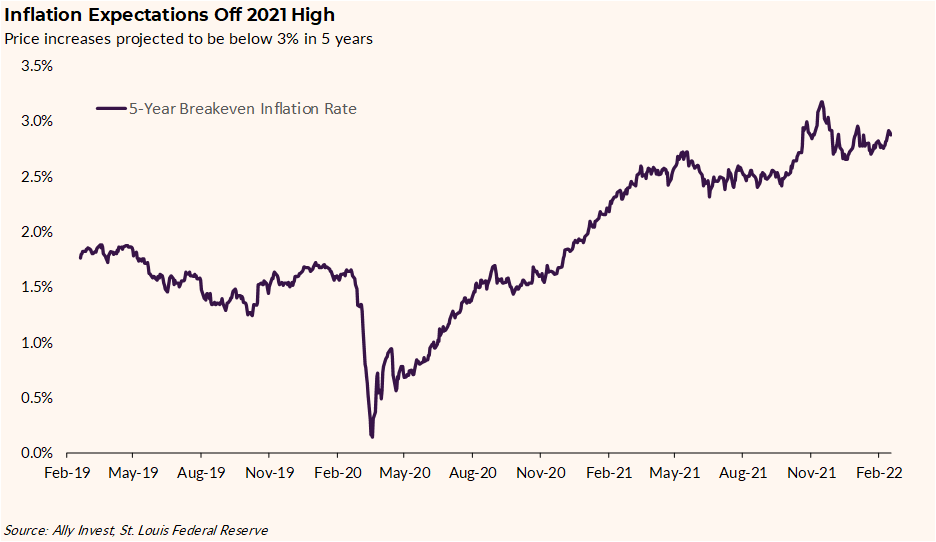Inflation: Will you stay or will you go?
LINDSEY BELL • Feb. 18, 2022 • 4 min read
Inflation is red hot.
This week, producer prices confirmed the four-decade high in consumer prices (or CPI) may remain intact near-term. Then, the latest retail sales report showed the consumer isn’t flinching at higher prices, at least at this time. Weighing on the minds of consumers and investors alike is the debate on inflation: Will it cool off, or is it here to stay?
The uncertainty is reflected in the up and down moves in the market this week. It’s also reflected in the erratic expectations for interest rate moves. The Federal Reserve is the best defense against persistent inflation, and it’s expected to take action in March. Yet, the size of its move is uncertain. Geopolitical tensions have some thinking the Fed will have to take a slower approach to raising rates. Despite what happens in March, inflation will be in the driver’s seat for what comes next with rates over the next 12 months.
Let’s look at some of the clues to figure out where inflation goes from here.
Here to stay?
It’s the million-dollar question. And the argument for brighter days is growing. Some recent data for consumer and market expectations indicate the rise in consumer prices will likely cool off — particularly in the back half of the year. A survey by the New York Fed revealed that consumers see retail prices coming down over the next 12 months. That was the first decrease since October 2020. Investors, too, have chilled on the inflation outlook — while still above the Fed’s comfort level, the five-year breakeven inflation rate (a measure of where investors think inflation will be in five years) peaked just shy of 3.2% last November. It’s currently below 3%.

Despite this, a recent Ally survey showed that more than 60% of consumers plan to postpone purchases because of higher prices, which is the opposite of what typically happens when inflation heats up. Consumers also said they are anticipating spending less, rather than dipping into their savings to offset higher prices. I applaud the commitment to the rainy day fund! However, if consumers indeed pare back expenditures, that could dampen demand, allowing retail prices to retreat.
Inventories could also provide some clues as to the longevity of the hot inflation we are currently experiencing. In the past five months, inventories have been on the rise, and now inventories are just 2.2% below pre-pandemic levels. This is a sign that supply chain issues are easing. And if inventory levels keep rising, that could limit companies’ ability to continue passing higher costs to consumers. It’s more difficult to do so when supply exceeds demand.
The pandemic driven supply chain issues significantly impacted transportation costs. Data is now showing that this hard-hit component of inflation is showing signs of relief. Even the World Trade Organization recently voiced optimism that the demand shock behind global bottlenecks should ease over the ensuing months. While supply chains can’t be fixed overnight, these are encouraging signs that high levels of inflation may ease.
Hot in here
Higher housing prices, commodity prices and rising wages have significantly impacted the inflation picture. Housing and wage increases have a longer lasting impact on inflation, as they are slower to change. Given the strength of the labor market, where job openings significantly outpace available workers, wage growth may be here for a while. For the housing market, affordability has declined drastically, which should result in a stabilizing or decline in home prices, but demand has yet to allow that to materialize. Because of these trends, many think higher inflation could be here to stay.
The bottom line
There is a lot to consider when trying to determine where inflation goes from here. Most economists and central bankers have gotten it wrong so far. There are reasons to believe inflation will remain at lofty levels in the near-term: high commodity prices, producer prices, the ability of consumers to accept higher prices, a still strong economy, etc. There are also lots of signs that things could cool off later this year.
What should investors do? At this time many of the “inflation plays” (think energy-related stocks, Treasury Inflation-Protected Securities (TIPS), value stocks, etc.) have already adjusted to elevated inflation realities. Often investors turn to the S&P 500 as an inflation hedge given it has outperformed inflation most of the time. If you believe corporations and the economy can continue to manage through higher cost of goods until we get to the latter part of the year, an investment in equities could work out in your favor.
Lindsey Bell is an award-winning investment professional with a passion for personal finance and more than 17 years of Wall Street experience. Bell’s unique ability to connect the dots between data and real life and craft bite-sized money ideas that people can use and apply stems from her deep background as an analyst, researcher and portfolio manager at organizations including J.P. Morgan and Deutsche Bank. She is known for demonstrating why and how an understanding of all things money improves a person’s finances and overall well-being. An ongoing CNBC contributor, Bell empowers consumers and investors across all walks of life and frequently shares her insights with the Wall Street Journal, Barron’s, Kiplinger’s, Forbes and Business Insider. She also serves on the board of Better Investing, a non-profit focused on investment education.
Read next
 Stagflation vs. inflation: How your portfolio can navigate these market trends
Stagflation vs. inflation: How your portfolio can navigate these market trends
Feb. 22, 2022 • 2 min read
Money solutions and strategies sent straight to your inbox.
Tips and tools to help you build your best financial future.

